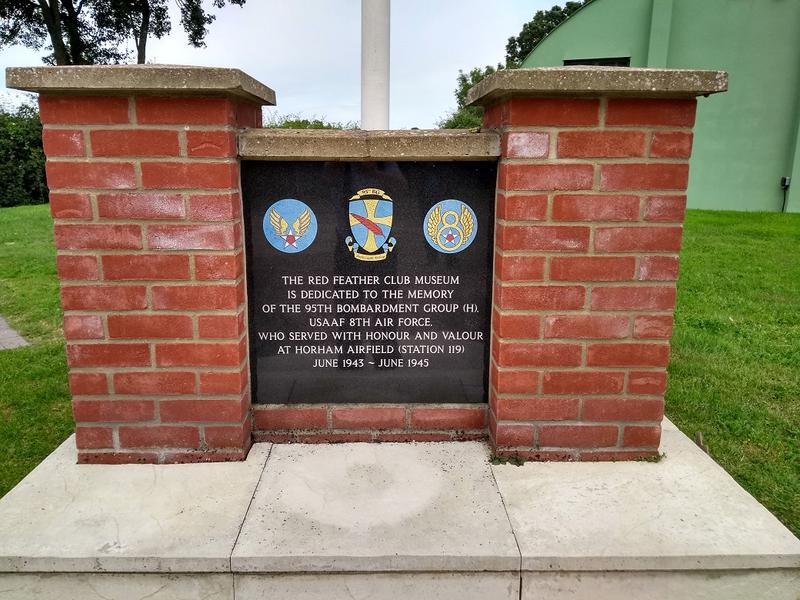95th Bombardment Group Museum Monument
Details:
In front of the museum.
A brick wall with outer pillars and the central section with black, polished granite stone on its front having three colored insignias of the United States Air Force, 95th BG, and 8th Air Force, on the top. Then, followed by a dedication message in English in white and incised lettering. A flagpole is situated behind the wall. The monument stands on a low and paved platform. The monument is in particular to the Red Feather Club Museum which, is dedicated to the 95th Bombardment Group.
Planned originally for RAF use, Horham airfield was provided to the United States Army Air Forces Eighth Air Force in 1942. Horham was given the USAAF designation Station 119 (JH). From 13 September 1943 through 6 August 1945, Horham served as headquarters for the 13th Combat Bombardment Wing of the 3d Bomb Division.
the 95th Bombardment Group (Heavy) arrived from RAF Framlingham on 15 June 1943. the 95th was assigned to the 13th Combat Bombardment Wing, and the group tail code was a "Square-B". Its operational squadrons were:
- 334th Bombardment Squadron (BG)
- 335th Bombardment Squadron (OE)
- 336th Bombardment Squadron (ET)
- 412th Bombardment Squadron (QW)
The group flew the B-17 Flying Fortress as part of the Eighth Air Force's strategic bombing campaign and began bombing strategic objectives in Germany in July 1943 and engaged primarily in such operations until V-E Day. Targets included harbors, industries, marshaling yards, and cities.
The group received a Distinguished Unit Citation for maintaining a tight defensive formation in spite of severe assault by enemy fighters and bombing the aircraft assembly plant at Regensburg on 17 August 1943. Withstanding concentrated attacks by fighters during the approach to the target and intense antiaircraft fire directly over the objective, the group effectively bombarded marshaling yards at Münster on 10 October 1943, being awarded a 2d DUC for the performance.
The unit participated in the intensive campaign of heavy bombers against the German aircraft industry during Big Week, 20–25 February 1944. Received a 3d DUC for action during an attack by Army Air Force bombers on Berlin on 4 March 1944. While many participating organizations, because of weather conditions, either abandoned the operation or struck other targets, the 95th proceeded to Berlin and successfully bombed a suburb of the German capital despite snowstorms, dense clouds, and severe enemy attacks.
The 95th interrupted its strategic operations to strike coastal defenses and communications during the invasion of Normandy in June 1944. The group hit enemy troop concentrations and thus assisted the Allied breakthrough at Saint-Lô in July 1944. The unit dropped ammunition, food, and medical supplies to Polish troops in Warsaw on 18 September 1944, and attacked enemy transportation during the Battle of the Bulge, December 1944 - January 1945 and bombed airfields in support of the Allied assault across the Rhine in March 1945.
The unit flew its last combat mission, an attack on marshaling yards at Oranienburg, on 20 April 1945. On 7 May 1945, the 95th flew a 'Chowhound' mission over German-occupied Holland. These missions, to drop supplies and food to Dutch civilians in German-occupied territory, were carried out by the RAF and USAAF, the German authorities having given safe passage to these humanitarian flights. On the return leg B-17G 44-48640 overflew the Dutch port of IJmuiden, then a German E-boat base, and was fired on by an SS machine gun unit, which scored hits on the aircraft including No 2 engine which caught fire. The aircraft went down in the sea about 3½ miles off Southwold, Suffolk. Of the 8 crew and 5 passengers on board, there were four survivors.
This was the last B-17 shot down in the European Theatre of Operations. After V-E Day, transported liberated prisoners and displaced persons from Austria to France and England. The 95th Bomb Group returned to Sioux Falls AAF South Dakota during June–August 1945, where the personnel were demobilized and aircraft sent to storage.
Source of information: www.warmemorialsonline.org.uk, Imperial War Museum War Memorials Register, military-history.fandom.com
Source of photos: Imperial War Museum War Memorials Register
Monument Text:
THE RED FEATHER CLUB MUSEUM
IS DEDICATED TO THE MEMORY
OF THE 95TH BOMBARDMENT GROUP (H),
USAAF 8TH AIR FORCE,
WHO SERVED WITH HONOUR AND VALOUR
AT HORHAM AIRFIELD (STATION 119)
JUNE 1943 - JUNE 1945
Commemorates:
Units:
8th Air Force
95th Bomb Group (Heavy)
US Army Air Corps
Wars:
WWII

